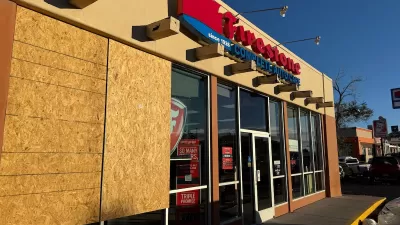French President Sarkozy's call for 'audacious' plans for a Paris of the future has been answered by some of the world's top architects and designers, but some wonder how any of the plans can work within the constraints of the existing city.
"In the past two months, architects and planners from all over the world have conjured up...ideas for a bigger, bolder Paris.
Their metropolis is still imaginary, but President Nicolas Sarkozy has said he is serious about creating what he calls the Grand Paris (Greater Paris) of the future. In an ambitious exercise in function and fantasy, he has launched an international competition to create a vision for the city.
'Be audacious,' Mr. Sarkozy urged architects when he announced the project: Apply energy-efficient and environmentally sensitive technology to create the first 'post-Kyoto' urban centre. Few other limits were set. The thorny question of the future political configuration of the Paris metropolitan region was left aside for the politicians. Competitors were free to draw the geographical boundaries of a future Paris as they thought best.
Some of the biggest names in architecture - including Jean Nouvel of France, Richard Rogers of Britain and Rem Koolhaas of the Netherlands - accepted the challenge. In all, 38 groups submitted proposals last month. No details have been released, but Mr. Sarkozy is expected to announce the 10 winning teams next week. Each will then produce an in-depth plan by year's end.
The competition has been welcomed as a once-in-a-lifetime opportunity for creative thinking on a large scale in a European setting.
Still, many urban experts and architects also suspect that it may never amount to more than an exercise - or produce only one or two prestige projects that Mr. Sarkozy could claim as his legacy.
The days when a French head of state could order up sweeping changes in Paris ended with Napoleon, they say. Big urban projects, which almost certainly would require major changes in public transit and rail lines, also cost big money. The biggest obstacle may be that deciding on a common vision for Greater Pariswould entail an unprecedented degree of political co-operation.
Still, there is general agreement among architects and urban specialists that the region badly needs a visionary road map for the future."
FULL STORY: The president pulls a switch on the City of Light

Maui's Vacation Rental Debate Turns Ugly
Verbal attacks, misinformation campaigns and fistfights plague a high-stakes debate to convert thousands of vacation rentals into long-term housing.

Planetizen Federal Action Tracker
A weekly monitor of how Trump’s orders and actions are impacting planners and planning in America.

Chicago’s Ghost Rails
Just beneath the surface of the modern city lie the remnants of its expansive early 20th-century streetcar system.

Bend, Oregon Zoning Reforms Prioritize Small-Scale Housing
The city altered its zoning code to allow multi-family housing and eliminated parking mandates citywide.

Amtrak Cutting Jobs, Funding to High-Speed Rail
The agency plans to cut 10 percent of its workforce and has confirmed it will not fund new high-speed rail projects.

LA Denies Basic Services to Unhoused Residents
The city has repeatedly failed to respond to requests for trash pickup at encampment sites, and eliminated a program that provided mobile showers and toilets.
Urban Design for Planners 1: Software Tools
This six-course series explores essential urban design concepts using open source software and equips planners with the tools they need to participate fully in the urban design process.
Planning for Universal Design
Learn the tools for implementing Universal Design in planning regulations.
planning NEXT
Appalachian Highlands Housing Partners
Mpact (founded as Rail~Volution)
City of Camden Redevelopment Agency
City of Astoria
City of Portland
City of Laramie




























